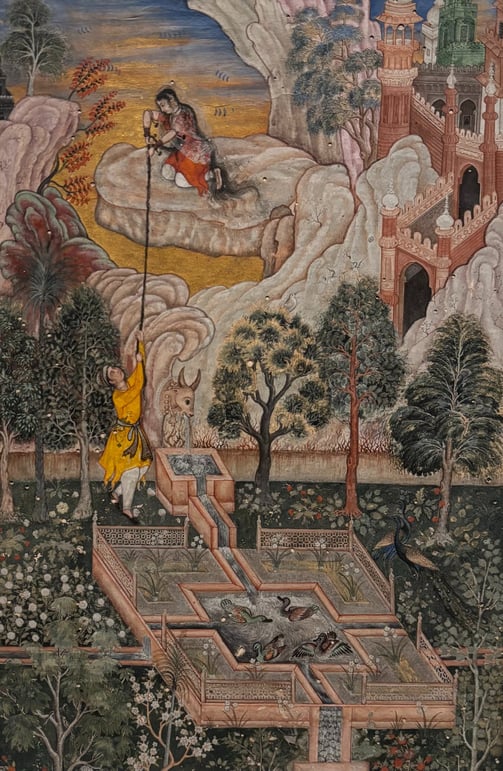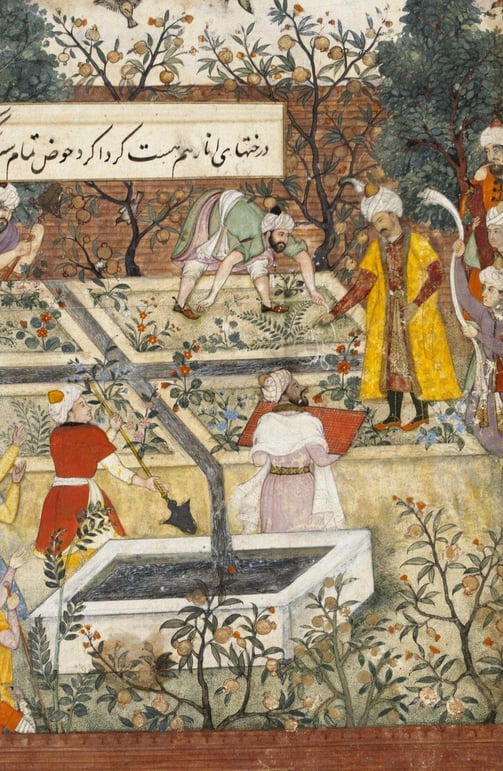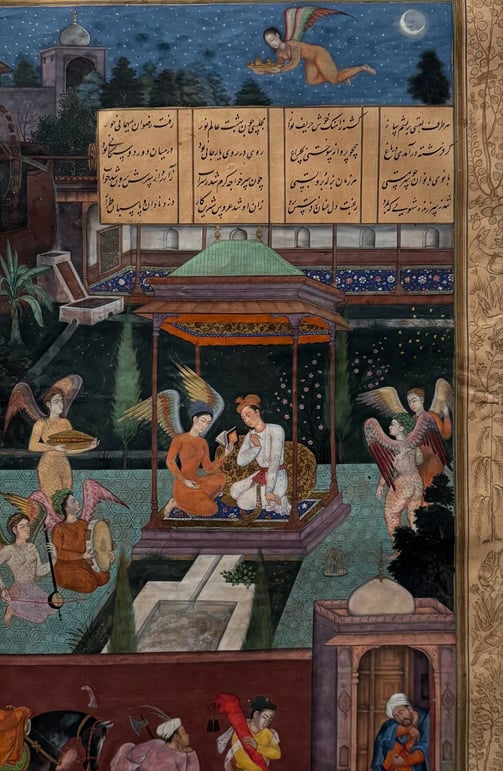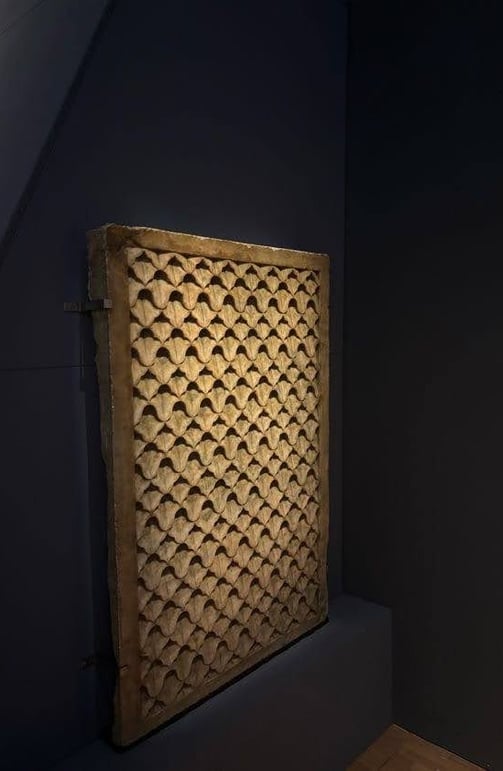‘If there is paradise on earth, it is this, it is this, it is this!’ - Mughal Gardens as Landscapes of Imperial Power
As the beautiful Rudabeh lowers her hair for her lover Zal, peacocks roam listlessly amongst lush foliage, flowers, fruits, and trees. A raft of ducks observe the action, bathing in the coolness of a neat, square pool that divides the curated landscape into quadrants - the four gardens of paradise. Painted in a Mughal manuscript of 'Shahnama' c.1590 and on display at the V&A’s ‘The Great Mughals’ until May 5th 2025, this illustration highlights a key symbol of Mughal imperial power - the garden.
11/25/2024


In 1526, Zahir al-Din Muhammad Babur defeated Sultan Ibrahim Lodi at the Battle of Panipat and two years later he ordered the construction of a chahar bagh to commemorate this victory. The Mughal Empire was born in a garden.
Yet, to Babur, this victory seemed bleak. Documented in his autobiographical memoir, the Baburnama, he declared that ‘the cities and provinces of Hindustan are all unpleasant…the gardens have no walks, and most places are flat as boards.’ His disappointment is hardly surprising given the opulence of the chahar baghs, mosques, madrasas, and tombs that coloured his former life in Herat and Samarqand - a vision not unlike the setting of Rudabeh and Zal’s rendezvous. In homage to his roots, Babur sought to emulate these markers of Central Asian excellence in India by ordering gardens and orchards to be laid out in all large cities. Bagh-e-Babur in Kabul was the first. In the painting shown at the top, Babur superintends the garden’s creation, occupying a command over the labouring men. His role as head gardener is a clear metaphor for the authoritative, god-like role he prescribes over the budding empire. Even the architectural style of the garden, the chahar bhag, with its clear, neat and symmetrical division reflects the mark of a ruler whose power could tame the disorderly ‘zig-zag and irregular’ landscape into one that is ‘straight and orderly.’
His successors furthered this legacy, building imperial gardens as key sites of socio-political, cultural, spiritual, and economic power. They were an important refuge site during the emperor’s journeys across the land; a sacred place of religious pilgrimage; and a laboratory to experiment with the latest horticultural technologies. The various political and spiritual meanings and symbols imbued in the construction, preservation and aesthetics of the gardens, did not function in isolation but rather in tandem with each other, thus legitimising the Emperor’s divine rights to rule. During the reign of Shah Jahan, who constructed the most enduring and famous gardens like the Mahtab Bagh which houses the Taj Mahal, these sites characterised the imperial polity, displaying the emperor’s command over the land, the abundance of earth’s gifts to mankind, and God’s blessings over the empire.
Whilst Babur’s gardens were a homage to his Central Asian origins, under his grandson Akbar, this space began to represent a distinctly Mughal identity. As Akbar extended Mughal power across the subcontinent, he became ruler of an increasingly diverse population which required calculated management and negotiation with his new, non-Muslim, subjects. The policy of sulh-i-khul, 'peace with all', accommodated differences by fostering a culture of active pluralism. Going beyond mere taqlid (adherence to dogma), Akbar’s court prompted tahqiq (commitment to rational inquiry) which subsequently saw Hindu Brahmins, Portuguese Jesuits, Jains, Turks, Iranians, Sunnis and Shi’as receive courtly patronage. Akbar also cemented strategic alliances with Rajput clans through marital relations. His own wife, Mariam-uz-Zamani (recognised in popular culture as ‘Jodha Bai’), was the daughter of the Rajput ruler of Amer. These policies promoted a culture of ‘hybridisation’ in the visual and architectural arts of the empire. Humayun’s Tomb, constructed in 1558, is a great example that reflects the synthesis of Central Asian, Persian and local traditions. This complex garden was formed with six-by-six equal plots. They represented a merge between the fourfold char bagh and a three-by-three arrangement, a homage to the mandala pattern typically found in Hindu temple plans. The chhatri structures on the tomb were also typical features of Rajasthani buildings. These characteristic features of Mughal architecture were initially fashioned from cross-cultural contact.
Mughal gardens intertwined imperial and divine power through the architectural emphasis on paradise. The chahar bagh design divides a quadrilateral garden using flowing water (or walkways) into four smaller parts, representing the four gardens of Paradise in the Qur’an. The construction of the hydraulic system was an impressive feat. Aside from the gardens in Kashmir that had natural streams and springs, elsewhere in the empire, water was artificially bought into the space. This was achieved by labourers pulling buckets on ropes or filtered in by aqueducts and pipes from high-level cisterns located outside the garden walls. These dynamic water features symbolised the central source of life, creating a nourishing ambience and permeating the landscape with spiritual significance. Other architectural features, like the chadar (water chute) that is pictured below, magnified these qualities audibly for the water would create a pleasant trickling sound as it cascaded over the the carved stone. Even the leaf-like design of the chute, emphasises the paradisical ambience of the space.
Bibliography:
A. A. Husain, Scent in the Islamic Garden: A Study of Deccani Urdu Literary Sources (2000)
C. B Asher, ‘Babur and the Timurid Char Bagh’ in Environmental Design: Journal of the Islamic Environmental Design Research Centre (1991)
C. Mukerji, ‘The Landscape Garden as Material Culture: Lessons from France’ in The Oxford Handbook of Material Culture Studies ed Dan Hicks and Mary C Beaudry (2010)
G. Michell. Mughal Architecture and Gardens (2011)
I. Habib, ‘Notes on the Economic and Social Aspects of Mughal Gardens’ in Mughal Gardens: Sources, Places, Representations, and Prospects (1996)
J. Wescoat and J. Wolschke-Bulmahn, Mughal Gardens: Sources, Places, Representations, and Prospects (1996)
L. Balabanlilar, ‘The Emperor Jahangir and the Pursuit of Pleasure’ in Journal of the Royal Asiatic Society 2009
S. Sharma, Mughal Arcadia: Persian Literature in an Indian Court (2017)


Zal approaches the palace of Rudabeh
Page from the manuscript of Ferdowsi's Shah-Nama, c.1590
Painting
Illustration from Baburnama, Babur supervising the laying of a Kabul garden, by Bishndas, opaque watercolour on paper, c1590
https://collections.vam.ac.uk/item/O17687/painting-bishndas/




The story of the Princess of the Blue Pavilion
Folio from Khamsa (Five Stories) of Amir Khusrau Dehlavi, probably Lahore, AH 1006. 1597-8. The text by the caligrapher Muhammad Husayn Kashmiri Zarrin. Opaque watercolour and gold on paper, 25.1 x 15.9 cm.
Water chute (chadar)
c1650. Folio from Khamsa (Five Stories)
The paradisical connotations of these gardens were further imbued in their horticultural functions. They produced high-quality fruits and flowers, a characteristic evident in Persian poetry describing the sites. Zafar Khan’s poem Jalva-yi naz catalogues almonds, pistachios, sour cherries, pears, and mango growing in Nishat Bagh, Nur Jahan’s garden in Kashmir. The gardens became laboratories for horticultural experiments, attesting to the medieval Muslim world's longstanding interest in botany and the natural world. In the Nishat Bagh, Nur Jahan’s mother observed the formation of an oil-like substance when warm rose water was distilled from the alembic. When collected, these drops of oil emitted a strong and pleasing fragrance which carried medicinal and cosmetic significance. As Ibn Sina’s acclaimed writings on Yunani state, ‘Scent is the food of the soul.’ Olfaction was one vital way of restoring and refreshing the body’s balance of the humours. The plethora of fruits and flowers in their various colours, textures and scents had transformative and replenishing qualities on the body, understood in their entirety to be the gifts of god (Surah An-Nahl, Verse 11). Horticultural practices were bestowed with sanctity and revered for their value and richness.
Symbolically, the gardens carried a fantastical quality, evident in the rich visual culture of the era. A folio from Amir Khusrau’s Khamsa depicts a princess recounting a story to the king Bahram Gur where a prince meets a fairy queen in a garden. This illustration has a highly enchanting and whimsical feel; from the twinkling stars and luminous crescent moon in the deep blue sky, to the rainbow-winged fairies fluttering around the page. The shimmery gold border heightens the iridescent quality of the scene. In literature, gardens often form the location of dream-like endeavours as a setting where the realm between the worlds of man and a higher power becomes thin. Humankind was born in, and cast from The Garden. Despite the scene’s ethereal qualities, the garden remains neat, tidy and symmetrical in typical Mughal fashion - a realistic component of the image which grounds the scene. The contrast between fantasy and reality transforms the garden into an arena of possibility. Nature, paradise, magic, and God become one in the garden.
Besides the symbolic significance of these spaces, the gardens also functioned as socio-political sites to strengthen Mughal rule over the subcontinent. The imperial court had a peripatetic nature so the emperor travelled regularly to foster loyalty with key nobles, strengthen governance over the land, supervise building projects, and squash rebellion. This constant displacement is well-documented in the Jahangirnama for the emperor’s longest period of residence in one place was under five years. The travelling court served the key function of strengthening central imperial authority. For example, Jahangir relocated the court to Lahore in 1606 and then to Kabul in 1607 to crush his son’s rebellion. The gardens were constructed for the court to reside in during these journeys. However, through the beauty and splendour of this manicured landscape, the emperor also communicated his visual, audible, and olfactory control over the land to key political players. This message was not restricted to the elites. Tomb gardens, like the Taj Mahal, were sites of pilgrimages where a broader cross-section of imperial subjects had access to a space that wove together the imperial and the divine.
As Babur towers over the construction of his chahar bagh, taming nature into an orderly and symmetrical landscape reminiscent of paradise, he confronts the age-old battle between man and nature. As landscapes of power, Mughal gardens were sites in the imperial polity that showed the emperor’s authority in all its glory. What can be a greater display of divine power than a mastery over the natural world? Like the V&A exhibition showcasing the ‘Golden Age’ of Mughal art, these paintings, literature, and architecture highlight the beauty, glory, and spiritual symbolism of the renowned Mughal gardens. They were also sites of knowledge production, scientific discoveries, and technological advancements. However, the conflict that is bound to have arisen in the negotiation between ecological knowledge and technical mastery remains obscure in these sources. A fine balancing act was at play for the emperor could not be greater than God.